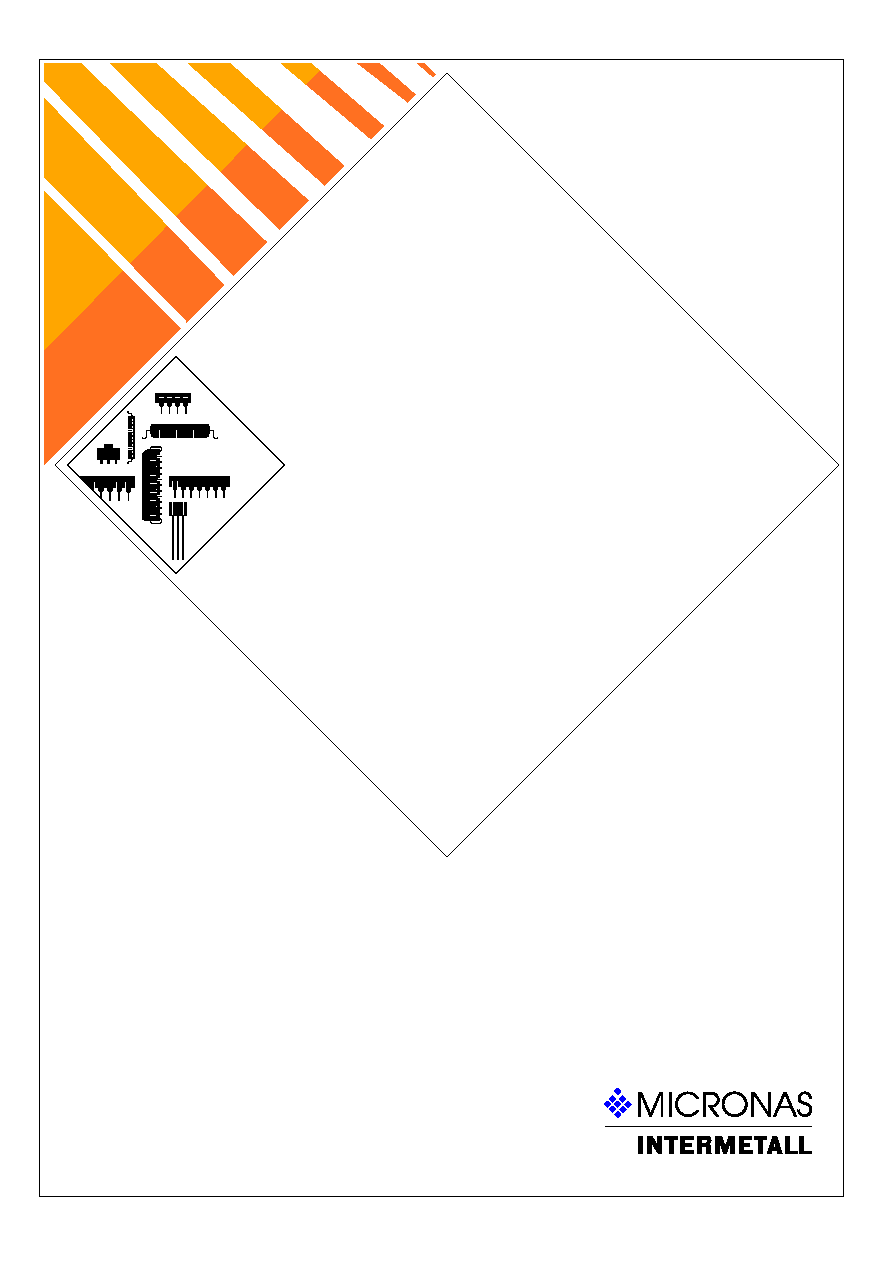
MSP 34x1G
PRELIMINARY DATA SHEET
2
MICRONAS INTERMETALL
Contents
Page
Section
Title
6
1.
Introduction
7
1.1.
Features of the MSP 34x1G Family and Differences to MSP 34xxD
7
1.2.
MSP 34x1G Version List
8
1.3.
MSP 34x1G Versions and their Application Fields
9
2.
Functional Description
10
2.1.
Architecture of the MSP 34x1G Family
10
2.2.
Sound IF Processing
10
2.2.1.
Analog Sound IF Input
10
2.2.2.
Demodulator: Standards and Features
11
2.2.3.
Preprocessing of Demodulator Signals
11
2.2.4.
Automatic Sound Select
11
2.3.
Preprocessing for SCART and I
2
S Input Signals
13
2.4.
Source Selection and Output Channel Matrix
13
2.5.
Audio Baseband Processing
13
2.5.1.
Automatic Volume Correction (AVC)
13
2.5.2.
Loudspeaker and Headphone Outputs
13
2.5.3.
Subwoofer Output
13
2.5.4.
Quasi-Peak Detector
14
2.6.
Virtual Surround System Application Tips
14
2.6.1.
Sweet Spot
14
2.6.2.
Clipping
14
2.6.3.
Loudspeaker Requirements
14
2.6.4.
Cabinet Requirements
15
2.7.
SCART Signal Routing
15
2.7.1.
SCART DSP In and SCART Out Select
15
2.7.2.
Stand-by Mode
15
2.8.
I
2
S Bus Interface
16
2.9.
ADR Bus Interface
16
2.10.
Digital Control I/O Pins and Status Change Indication
16
2.11.
Clock PLL Oscillator and Crystal Specifications
17
3.
Control Interface
17
3.1.
I
2
C Bus Interface
17
3.1.1.
Device and Subaddresses
18
3.1.2.
Description of CONTROL Register
19
3.1.3.
Protocol Description
20
3.1.4.
Proposals for General MSP 34x1G I
2
C Telegrams
20
3.1.4.1.
Symbols
20
3.1.4.2.
Write Telegrams
20
3.1.4.3.
Read Telegrams
20
3.1.4.4.
Examples
21
3.2.
Start-Up Sequence: Power-Up and I
2
C Controlling
21
3.3.
MSP 34x1G Programming Interface
21
3.3.1.
User Registers Overview
25
3.3.2.
Description of User Registers
26
3.3.2.1.
STANDARD SELECT Register

Contents, continued
Page
Section
Title
PRELIMINARY DATA SHEET
MSP 34x1G
MICRONAS INTERMETALL
3
26
3.3.2.2.
Refresh of STANDARD SELECT Register
27
3.3.2.3.
STANDARD RESULT Register
28
3.3.2.4.
Write Registers on I
2
C Subaddress 10
hex
29
3.3.2.5.
Read Registers on I
2
C Subaddress 11
hex
30
3.3.2.6.
Write Registers on I
2
C Subaddress 12
hex
43
3.3.2.7.
Read Registers on I
2
C Subaddress 13
hex
44
3.4.
Programming Tips
44
3.5.
Examples of Minimum Initialization Codes
44
3.5.1.
SCART1 Input to Loudspeaker in Stereo Sound
44
3.5.2.
SCART1 Input to Loudspeaker in 3D-PANORAMA Sound
44
3.5.3.
Noise Sequencer for 3D-PANORAMA Sound
45
3.5.4.
B/G-FM (A2 or NICAM)
45
3.5.5.
BTSC-Stereo
45
3.5.6.
BTSC-SAP with SAP at Loudspeaker Channel
45
3.5.7.
FM-Stereo Radio
45
3.5.8.
Automatic Standard Detection
45
3.5.9.
Software Flow for Interrupt driven STATUS Check
47
4.
Specifications
47
4.1.
Outline Dimensions
49
4.2.
Pin Connections and Short Descriptions
52
4.3.
Pin Descriptions
55
4.4.
Pin Configurations
59
4.5.
Pin Circuits
61
4.6.
Electrical Characteristics
61
4.6.1.
Absolute Maximum Ratings
62
4.6.2.
Recommended Operating Conditions (T
A
= 0 to 70
∞
C)
62
4.6.2.1.
General Recommended Operating Conditions
62
4.6.2.2.
Analog Input and Output Recommendations
63
4.6.2.3.
Recommendations for Analog Sound IF Input Signal
64
4.6.2.4.
Crystal Recommendations
65
4.6.3.
Characteristics
65
4.6.3.1.
General Characteristics
66
4.6.3.2.
Digital Inputs, Digital Outputs
67
4.6.3.3.
Reset Input and Power-Up
68
4.6.3.4.
I
2
C-Bus Characteristics
69
4.6.3.5.
I
2
S-Bus Characteristics
70
4.6.3.6.
Analog Baseband Inputs and Outputs, AGNDC
72
4.6.3.7.
Sound IF Inputs
72
4.6.3.8.
Power Supply Rejection
73
4.6.3.9.
Analog Performance
76
4.6.3.10.
Sound Standard Dependent Characteristics

MSP 34x1G
PRELIMINARY DATA SHEET
4
MICRONAS INTERMETALL
Contents, continued
Page
Section
Title
79
5.
Appendix A: Overview of TV-Sound Standards
79
5.1.
NICAM 728
80
5.2.
A2-Systems
81
5.3.
BTSC-Sound System
81
5.4.
Japanese FM Stereo System (EIA-J)
82
5.5.
FM Satellite Sound
82
5.6.
FM-Stereo Radio
83
6.
Appendix B: Manual/Compatibility Mode
84
6.1.
Demodulator Write and Read Registers for Manual/Compatibility Mode
85
6.2.
DSP Write and Read Registers for Manual/Compatibility Mode
86
6.3.
Manual/Compatibility Mode: Description of Demodulator Write Registers
86
6.3.1.
Automatic Switching between NICAM and Analog Sound
86
6.3.1.1.
Function in Automatic Sound Select Mode
86
6.3.1.2.
Function in Manual Mode
87
6.3.2.
A2 Threshold
87
6.3.3.
Carrier-Mute Threshold
88
6.3.4.
Register AD_CV
89
6.3.5.
Register MODE_REG
91
6.3.6.
FIR-Parameter, Registers FIR1 and FIR2
91
6.3.7.
DCO-Registers
93
6.4.
Manual/Compatibility Mode: Description of Demodulator Read Registers
93
6.4.1.
NICAM Mode Control/Additional Data Bits Register
93
6.4.2.
Additional Data Bits Register
93
6.4.3.
CIB Bits Register
94
6.4.4.
NICAM Error Rate Register
94
6.4.5.
PLL_CAPS Readback Register
94
6.4.6.
AGC_GAIN Readback Register
94
6.4.7.
Automatic Search Function for FM-Carrier Detection in Satellite Mode
95
6.5.
Manual/Compatibility Mode: Description of DSP Write Registers
95
6.5.1.
Additional Channel Matrix Modes
95
6.5.2.
Volume Modes of SCART1/2 Outputs
95
6.5.3.
FM Fixed Deemphasis
95
6.5.4.
FM Adaptive Deemphasis
95
6.5.5.
NICAM Deemphasis
96
6.5.6.
Identification Mode for A2 Stereo Systems
96
6.5.7.
FM DC Notch
96
6.6.
Manual/Compatibility Mode: Description of DSP Read Registers
96
6.6.1.
Stereo Detection Register for A2 Stereo Systems
96
6.6.2.
DC Level Register
96
6.7.
Demodulator Source Channels in Manual Mode
96
6.7.1.
Terrestric Sound Standards
96
6.7.2.
SAT Sound Standards
98
6.8.
Exclusions of Audio Baseband Features
98
6.9.
Phase Relationship of Analog Outputs

Contents, continued
Page
Section
Title
PRELIMINARY DATA SHEET
MSP 34x1G
MICRONAS INTERMETALL
5
99
7.
Appendix D: MSP 34x1G Version History
100
8.
Appendix E: Application Circuit
102
9.
Data Sheet History
License Notice:
1)
"Dolby", "Virtual Dolby Surround", and the double-D Symbol are trademarks of Dolby Laboratories.
Supply of this implementation of Dolby Technology does not convey a license nor imply a right under any patent, or
any other industrial or intellectual property right of Dolby Laboratories, to use this implementation in any finished
end-user or ready-to-use final product. Companies planning to use this implementation in products must obtain a
license from Dolby laboratories Licensing Corporation before designing such products.




